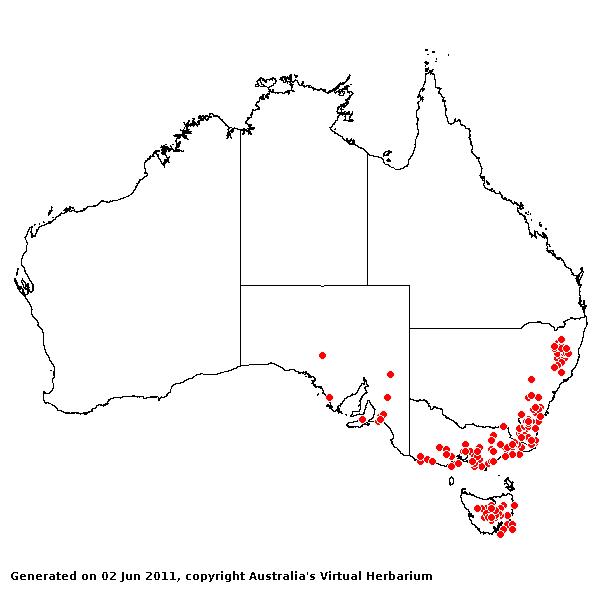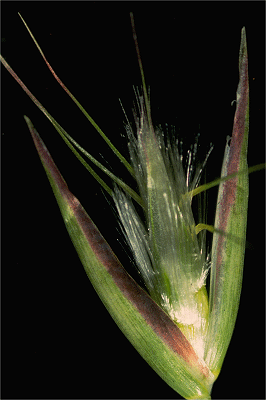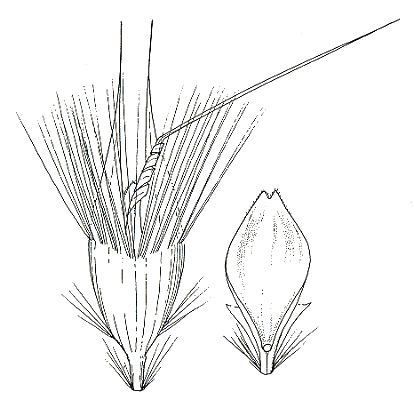Rytidosperma laeve (Vickery) Connor &
Edgar. New Zealand J. Bot. 17: 325 (1979).
Classification. (GPWG 2001) : Subfamily Danthonioideae. Tribe
Danthonieae.
Basionym and/or
Replacement Name: Danthonia
laevis Vickery, Contr. New South Wales Natl. Herb. 1(5): 299 (1950).
Type of Basionym or
Protologue Information: Australian Capitol Territory: Base of Mt. Stromlo,
26 Apr 1941, Melvaine s.n. (HT: NSW-3232).
Recent synonyms:
Notodanthonia laevis (Vickery) Zotov, Austrodanthonia laevis (Vickery)
H.P. Linder.
Key references
(books and floras): [2002] D.Sharp & B.K.Simon, AusGrass, Grasses of
Australia, [2006] J.Jessop, G.R.M.Dashorst, F.M.James, Grasses of South
Australia (293), [2008] S.W.L.Jacobs, R.D.B.Walley & D.J.B.Wheeler, Grasses
of New South Wales (144).
Illustrations:
[2005] K.Mallet (ed.), Flora of Australia 44B: Poaceae 3 (Fig.
11, A-B), [2006] J.Jessop, G.R.M.Dashorst, F.M.James, Grasses of South
Australia (293, Fig. 229), [2008]
S.W.L.Jacobs, R.D.B.Whalley & D.J.B.Wheeler, Grasses of New South Wales,
4th edn (144).
Derivation: L.
smooth. Lacking hairs or roughness, usually of leaf-blades or lemmas.
Habit.
Perennial. Culms erect, 20–60 cm tall, 2–4 -noded. Mid-culm nodes glabrous.
Leaf-sheaths glabrous on surface or hairy. Ligule a fringe of hairs.
Leaf-blades filiform, involute, 10–20 cm long, 1–1.5 mm wide. Leaf-blade surface
glabrous or indumented.
Inflorescence.
Inflorescence solid, a panicle. Panicle linear, 3–4 cm long.
Spikelets.
Spikelets pedicelled. Fertile spikelets many flowered, with at least 2 fertile
florets (4–6), comprising 4–6 fertile floret(s), with diminished florets at the
apex, cuneate, laterally compressed, 11–18 mm long.
Glumes. Glumes
similar, thinner than fertile lemma. Lower glume lanceolate, membranous, much
thinner on margins, without keels, 5–7 -nerved. Upper glume lanceolate, 11–18
mm long, membranous, without keels, 3–5 -nerved.
Florets.
Fertile lemma 3–4.5 mm long, without keel, 9 -nerved. Lemma apex lobed, awned,
3 -awned. Median (principal) awn from a sinus, 11–28 mm long overall, with a
twisted column. Lateral lemma awns present. Lodicules present. Anthers 3. Grain
1.8–2.2 mm long.
Continental
Distribution: Australasia.
Australian
Distribution: South Australia, New South Wales, Victoria, Tasmania.
South Australia:
Southern Lofty. New South Wales: North Coast, Central Coast, Northern
Tablelands, Central Tablelands, Southern Tablelands, North-Western Slopes,
Central-Western Slopes, South-Western Slopes. Victoria: East Gippsland,
Eastern Highlands, Gippsland Highlands, Gippsland Plain, Midlands, Otway Plain,
Snowfields, Volcanic Plain, Wannon. Tasmania: North East, West Coast,
Central Highlands, Midlands, Ben Lomond, East Coast, South West.
Notes. This is
a very distinctive species that cannot be confused with any others, but
superficially it may show some similarities to R. erianthum or A.
caespitosum.
Widespread
from the Queensland border to Adelaide and Tasmania, altitude 30–1500 m,
ecologically variable, from alpine moorland to open grassland or light
woodland, often in seasonally damp habitats.







